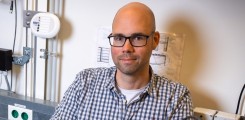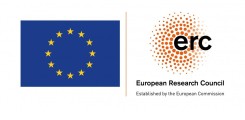Research group Schulz
The research group of Dr. Eike Schulz focuses on the molecular structure and dynamics of enzymes in the field of infection research.
The ANTIBIOTIMEX project focusses on the molecular mechanisms of antibiotic resistance enzymes.
The DynaPLIX project aims to unveil the dynamic process of ligand binding to proteins from a perspective that integrates structure, kinetics and thermodynamics.
The Schulz group is supported by the BMBF since July 2022 and the ERC since May 2023, with a volume of 2.2 M and 2.5 M Euro, respectively.
What are we interested in?
Antibiotic resistance is one of the biggest threads to human health in the 21st century. A key factor in developing new strategies against antimicrobial resistance is to understand the underlying molecular mechanisms. On a molecular level antibiotic resistance is conferred by specialised proteins, enzymes that modify, degrade, or secrete the antibiotics. To develop new treatment options against this threat we need to understand of how and why these proteins carry out their work. These processes are intimately coupled to the molecular motions of these enzyme - their dynamics. So far only static pictures of the involved enzymes are available, and therefore information about the order of events is scarce. However, to directly visualise and understand protein dynamics, my research group is actively developing a method called “time-resolved X-ray crystallography”. With this method we can move beyond static protein snapshots, but rather can record true biochemical movies of the molecules of life in action.
Time-resolved crystallography: how do enzymes work ?
Recording biochemical movies is challenging since it requires a determination of the structural dynamics while the protein carries out its work. To this end we make use of the most modern radiation sources, such as the PETRA-III synchrotron or free-electron lasers and the European XFEL, here in Hamburg. Previously these experiments were highly complicated and very much reserved for large teams of experts. However, one of the aims of my research group is to simplify time-resolved crystallography to increase the number of problems that can be tackled.
⁃
Best practices
⁃
Simplifying time-resolved crystallography
How is all of this related to antibiotic resistance ?
Like catalysis in all enzymes the inactivation of antibiotics is intimately connected to the motions of the protein. Typically, these ‘conformational changes’ determine how fast a reaction proceeds, in biochemical terms their ‘rate-limiting steps’. Thus, critical information lies in the molecular dynamics of the resistance enzymes, complicating the rational design of novel, more resilient inhibitors. But if only static structures of these enzymes are considered for drug discovery the important aspect of their dynamics is missed, and the activity of newly designed inhibitors could quickly become compromised by a single mutation. By contrast, targeting other sites on the protein, that is interfering with allosteric mechanisms or the conformational dynamics of proteins in general, is a promising route to circumvent these problems. In its modern understanding allostery is the process, by which proteins transmit signals about events at one site, e.g. the binding of a ligand, to another, often distant site, which allows e.g. for regulation of their activity. Canonical inhibitors compete with the substrate for the active site and are hence called competitive inhibitors. However, often these are rendered useless by a single point-mutation, re-instating resistance in bacteria. By contrast, allosteric inhibitors can bind distant from the active site and decrease the target proteins function by long range effects due to an alteration of the protein structure or its functional dynamics. Allostery is often linked to catalysis and to the conformational dynamics of a protein but the technical difficulties obtaining this information prevents further rational exploitation by academia or the pharmaceutical industry at the moment. Currently, conformational dynamics of the resting enzyme are predominantly obtained from NMR experiments or MD-simulations. However, with TR-SSX we can uniquely complement and extend these studies as the technique (a) reveals conformational dynamics during catalysis and (b) can cover hitherto inaccessibly long timeframes. Previously we have demonstrated that certain conformational modes are only visible during key catalytic events of an enzyme (Science 2019). Obtaining similar information for antibiotic resistance enzymes hopefully provides us with information about additional conformational states and allosteric effects, that should open new opportunities for e.g. inhibitor design
How do we do it?
A groundbreaking innovation was the hit-and-return (HARE)-method, that permits recording movies of proteins in action at biologically relevant time-scales.
Another technological breakthrough was the „liquid application methods for time-resolved crystallography“ (LAMA)-method, which allows us to initiate enzyme reactions by spitting the solution with the enzymes substrates (e.g. the antibiotics) onto the tiny protein crystals. This does not only further simplify the experiment but the main advantage of the LAMA method is that it greatly expands the problems that can be addressed. Both of these methods are now in routine multi-user operation by over 35 international user groups at the dedicated time-resolved crystallography beamline (TREXX), which is operated by our close collaboration partners at the EMBL Hamburg and the University of Hamburg EMBL Hamburg and the University of Hamburg
⁃ HARE
⁃ LAMA
What can we learn?
These innovative methods enabled unique hitherto unprecedented insight into protein function and dynamics, namely a process that can be understood as „molecular breathing“, the expansion and contraction of an enzyme correlated with its catalytic turnover reaction; a so called „half-the-sites reactivity“ which was not previously observed in molecular detail. Here only one half of the enzyme is active at a given time and the information about its catalytic state is communicated to the other of the enzyme via an intramolecular mechanism that surprisingly does not require the enzyme to change its shape. This behaviour is common in enzymes but is rarely visualised and still poorly understood. In addition, this initial work also demonstrated for the first time that time-resolved crystallography can also reveal ligand binding events, that is not only provide insight into the state before and after a small molecule has bound to a protein (e.g. an antibiotic) but also reveal intermediate states during the binding process. This last aspect displays an uncharted area in structural protein biochemistry.
Too complex for everyone?
Time-resolved crystallography has a reputation of being complex, requiring large teams of experts. However, the versatility of our recent developments encouraged us to make time-resolved crystallography even simpler and thus more accessible to the large structural biology community. To this end we have developed the spitrobot - a protein crystal plunger-, built around standard tools, enabling reaction quenching via cryo-trapping with millisecond time-resolution. This should accelerate research in the field of protein mechanisms and empower a larger number of groups to carry out similar research.
Multi-dimensional crystallography: why are enzyme working?
However, the bigger open question is why enzymes work? Enzymes stabilise the transition state and thereby lower the activation energy, but how is this barrier actually overcome? How can enzymes channel the energy present in the system towards their active sites? This challenging question requires a simultaneous understanding of structure, dynamics and thermodynamics during catalysis. Most of understanding of protein structure and function is derived from experiments that were conducted at cryogenic temperatures, that is at ~ -170°C. These temperatures are very far from physiological conditions and the optimal working environment for enzymes involved in antibiotic resistance. Thus, the information we have about the structures that govern our life could be affected by these artificial temperatures. For this reason, we have developed a serial crystallography solution that enables the modification of temperature, while we are observing turnover. This multi-dimensional crystallography setup permits conducting time-resolved experiments in a temperature window between 8°C and 80°C and is the technological basis for the determination of free-energy landscapes, which should educate us in the question why enzymes working.
Experimental Expertise
⁃ Protein biochemistry
⁃ Protein purification
⁃ Protein crystallization
⁃ X-ray crystallography
⁃ Time-resolved crystallography
⁃ Multi-dimensional crystallography
⁃ Method development
Team
If you are interested in a Master’s project in Biochemistry or Biophysics please inquire directly with me. Dr. Eike C. Schulz


